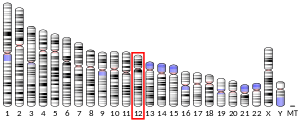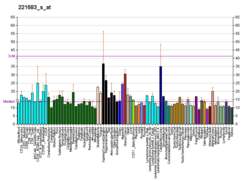CEP290
Centrosomal protein of 290 kDa is a protein that in humans is encoded by the CEP290 gene.[5][6][7][8] CEP290 is located on the Q arm of chromosome 12.
Function
The gene CEP290 is a centrosomal protein that plays an important role in centrosome and cilia development. This gene is vital in the formation of the primary cilium, a small antenna-like projections of the cell membrane that plays an important role in the photoreceptors at the back of the retina (which detect light and color) and in the kidney, brain, and many other organs of the body. Knocking down levels of the CEP290 gene transcript resulted in dramatic suppression of ciliogenesis in retinal pigment epithelial cells in culture, proving just how important CEP290 is to cilia formation.
On a molecular level, CEP290 has been shown to play a critical regulatory and structural role in primary cilium formation. Recent studies have implicated CEP290 as a microtubule and membrane binding protein that might serve as a structural link between the microtubule core of the cilium and the overlying ciliary membrane.[9] Disruption of CEP290's microtubule binding domain in the rd16 mouse model of CEP290 disease [7] has been shown to result in rapid and dramatic retinal degeneration, demonstrating the importance of CEP290 microtubule binding in disease. The role of CEP290 in promoting ciliogensis is inhibited both by auto-regulatory domains found at either end of the CEP290 protein [9] and through CEP290's interaction with the inhibitory protein CP110.[10]
The discovery of the CEP290 gene has led researchers to find another gene critical in retinal function, LCA5. Clinical trials involving gene replacement of these two genes have started in Philadelphia, where researchers are hopeful that Leber Congenital Amaurosis will one day be cured.[11][12][13]
Structure
This gene encodes a protein with 13 putative coiled-coil domains, a region with homology to SMC chromosome segregation ATPases, six KID motifs, three tropomyosin homology domains and an ATP/GTP binding site motif A. The protein is localized to the centrosome and cilia and has sites for N-glycosylation, tyrosine sulfation, phosphorylation, N-myristoylation, and amidation.[8]
Clinical significance
Mutations in this gene have been associated with Joubert syndrome and nephronophthisis, and recently with a frequent form of Leber's congenital amaurosis, called LCA10. The presence of antibodies against this protein is associated with several forms of cancer.[8]
A mutation in this gene leads to infant and child blindness, a disease known as Leber Congenital Amaurosis. As of today, 35 different mutations in CEP290 are responsible for causing LCA. Other mutations in CEP290 have also been identified in causing Meckel Syndrome and Joubert Syndrome, a few among many syndromes. A defective CEP290 gene is usually the cause of these disorders due to abnormal cilia. It is unknown how one mutation in a gene can cause so many different types of syndromes, particularly many of which affect the Central Nervous System.
References
- GRCh38: Ensembl release 89: ENSG00000198707 - Ensembl, May 2017
- GRCm38: Ensembl release 89: ENSMUSG00000019971 - Ensembl, May 2017
- "Human PubMed Reference:". National Center for Biotechnology Information, U.S. National Library of Medicine.
- "Mouse PubMed Reference:". National Center for Biotechnology Information, U.S. National Library of Medicine.
- Guo J, Jin G, Meng L, Ma H, Nie D, Wu J, Yuan L, Shou C (Oct 2004). "Subcellullar localization of tumor-associated antigen 3H11Ag". Biochem Biophys Res Commun. 324 (2): 922–30. doi:10.1016/j.bbrc.2004.09.133. PMID 15474516.
- Sayer JA, Otto EA, O'Toole JF, Nurnberg G, Kennedy MA, Becker C, Hennies HC, Helou J, Attanasio M, Fausett BV, Utsch B, Khanna H, Liu Y, Drummond I, Kawakami I, Kusakabe T, Tsuda M, Ma L, Lee H, Larson RG, Allen SJ, Wilkinson CJ, Nigg EA, Shou C, Lillo C, Williams DS, Hoppe B, Kemper MJ, Neuhaus T, Parisi MA, Glass IA, Petry M, Kispert A, Gloy J, Ganner A, Walz G, Zhu X, Goldman D, Nurnberg P, Swaroop A, Leroux MR, Hildebrandt F (May 2006). "The centrosomal protein nephrocystin-6 is mutated in Joubert syndrome and activates transcription factor ATF4". Nat Genet. 38 (6): 674–81. doi:10.1038/ng1786. PMID 16682973.
- Chang B, Khanna H, Hawes N, Jimeno D, He S, Lillo C, Parapuram SK, Cheng H, Scott A, Hurd RE, Sayer JA, Otto EA, Attanasio M, O'Toole JF, Jin G, Shou C, Hildebrandt F, Williams DS, Heckenlively JR, Swaroop A (May 2006). "In-frame deletion in a novel centrosomal/ciliary protein CEP290/NPHP6 perturbs its interaction with RPGR and results in early-onset retinal degeneration in the rd16 mouse". Hum Mol Genet. 15 (11): 1847–57. doi:10.1093/hmg/ddl107. PMC 1592550. PMID 16632484.
- "Entrez Gene: CEP290 centrosomal protein 290kDa".
- Drivas TG, Holzbaur EL, Bennett J (Oct 2013). "Disruption of CEP290 microtubule/membrane-binding domains causes retinal degeneration". J Clin Invest. 123 (10): 4525–39. doi:10.1172/JCI69448. PMC 3784542. PMID 24051377.
- Tsang WY, Bossard C, Khanna H, Peränen J, Swaroop A, Malhotra V, Dynlacht BD (Aug 2008). "CP110 suppresses primary cilia formation through its interaction with CEP290, a protein deficient in human ciliary disease". Dev Cell. 15 (2): 187–97. doi:10.1016/j.devcel.2008.07.004. PMC 3987787. PMID 18694559.
- Kniffin, Cassandra L. "OMIM Entry Centrosomal Protein 290-KD." Archived 2011-10-26 at the Wayback Machine N.p., 24 May 2006. Web. 30 Mar. 2013.
- "Genetics Home Reference Gene CEP290." . US National LIbrary of Medicine, 25 Mar. 2013. Web. 30 Mar. 2013.
- McGill University Health Centre. "Gene Responsible For Blindness In Infants And Children Identified." ScienceDaily, 4 Jun. 2007. Web. 30 Mar. 2013.
External links
- GeneReviews/NIH/NCBI/UW entry on Bardet-Biedl Syndrome
- Human CEP290 genome location and CEP290 gene details page in the UCSC Genome Browser.
- Human LCA10 genome location and LCA10 gene details page in the UCSC Genome Browser.
Further reading
- Bonaldo MF, Lennon G, Soares MB (1997). "Normalization and subtraction: two approaches to facilitate gene discovery". Genome Res. 6 (9): 791–806. doi:10.1101/gr.6.9.791. PMID 8889548.
- Nagase T, Ishikawa K, Nakajima D, et al. (1997). "Prediction of the coding sequences of unidentified human genes. VII. The complete sequences of 100 new cDNA clones from brain which can code for large proteins in vitro". DNA Res. 4 (2): 141–50. doi:10.1093/dnares/4.2.141. PMID 9205841.
- Eichmuller S, Usener D, Dummer R, et al. (2001). "Serological detection of cutaneous T-cell lymphoma-associated antigens". Proc. Natl. Acad. Sci. U.S.A. 98 (2): 629–34. doi:10.1073/pnas.021386498. PMC 14639. PMID 11149944.
- Chen D, Shou C (2001). "Molecular cloning of a tumor-associated antigen recognized by monoclonal antibody 3H11". Biochem. Biophys. Res. Commun. 280 (1): 99–103. doi:10.1006/bbrc.2000.4087. PMID 11162484.
- Strausberg RL, Feingold EA, Grouse LH, et al. (2003). "Generation and initial analysis of more than 15,000 full-length human and mouse cDNA sequences". Proc. Natl. Acad. Sci. U.S.A. 99 (26): 16899–903. doi:10.1073/pnas.242603899. PMC 139241. PMID 12477932.
- Shin BK, Wang H, Yim AM, et al. (2003). "Global profiling of the cell surface proteome of cancer cells uncovers an abundance of proteins with chaperone function". J. Biol. Chem. 278 (9): 7607–16. doi:10.1074/jbc.M210455200. PMID 12493773.
- Millar JK, Christie S, Porteous DJ (2004). "Yeast two-hybrid screens implicate DISC1 in brain development and function". Biochem. Biophys. Res. Commun. 311 (4): 1019–25. doi:10.1016/j.bbrc.2003.10.101. PMID 14623284.
- Andersen JS, Wilkinson CJ, Mayor T, et al. (2003). "Proteomic characterization of the human centrosome by protein correlation profiling". Nature. 426 (6966): 570–4. doi:10.1038/nature02166. PMID 14654843.
- Ota T, Suzuki Y, Nishikawa T, et al. (2004). "Complete sequencing and characterization of 21,243 full-length human cDNAs". Nat. Genet. 36 (1): 40–5. doi:10.1038/ng1285. PMID 14702039.
- Scherer SE, Muzny DM, Buhay CJ, et al. (2006). "The finished DNA sequence of human chromosome 12". Nature. 440 (7082): 346–51. doi:10.1038/nature04569. PMID 16541075.
- Valente EM, Silhavy JL, Brancati F, et al. (2006). "Mutations in CEP290, which encodes a centrosomal protein, cause pleiotropic forms of Joubert syndrome". Nat. Genet. 38 (6): 623–5. doi:10.1038/ng1805. PMID 16682970.
- den Hollander AI, Koenekoop RK, Yzer S, et al. (2006). "Mutations in the CEP290 (NPHP6) gene are a frequent cause of Leber congenital amaurosis". Am. J. Hum. Genet. 79 (3): 556–61. doi:10.1086/507318. PMC 1559533. PMID 16909394.
- Olsen JV, Blagoev B, Gnad F, et al. (2006). "Global, in vivo, and site-specific phosphorylation dynamics in signaling networks". Cell. 127 (3): 635–48. doi:10.1016/j.cell.2006.09.026. PMID 17081983.
- Perrault I, Delphin N, Hanein S, et al. (2007). "Spectrum of NPHP6/CEP290 mutations in Leber congenital amaurosis and delineation of the associated phenotype". Hum. Mutat. 28 (4): 416. doi:10.1002/humu.9485. PMID 17345604.
- Tory K, Lacoste T, Burglen L, et al. (2007). "High NPHP1 and NPHP6 mutation rate in patients with Joubert syndrome and nephronophthisis: potential epistatic effect of NPHP6 and AHI1 mutations in patients with NPHP1 mutations". J. Am. Soc. Nephrol. 18 (5): 1566–75. doi:10.1681/ASN.2006101164. PMID 17409309.
- Cideciyan AV, Aleman TS, Jacobson SG, et al. (2007). "Centrosomal-ciliary gene CEP290/NPHP6 mutations result in blindness with unexpected sparing of photoreceptors and visual brain: implications for therapy of Leber congenital amaurosis". Hum. Mutat. 28 (11): 1074–83. doi:10.1002/humu.20565. hdl:2027.42/57387. PMID 17554762.
- Brancati F, Barrano G, Silhavy JL, et al. (2007). "CEP290 mutations are frequently identified in the oculo-renal form of Joubert syndrome-related disorders". Am. J. Hum. Genet. 81 (1): 104–13. doi:10.1086/519026. PMC 1950920. PMID 17564967.





